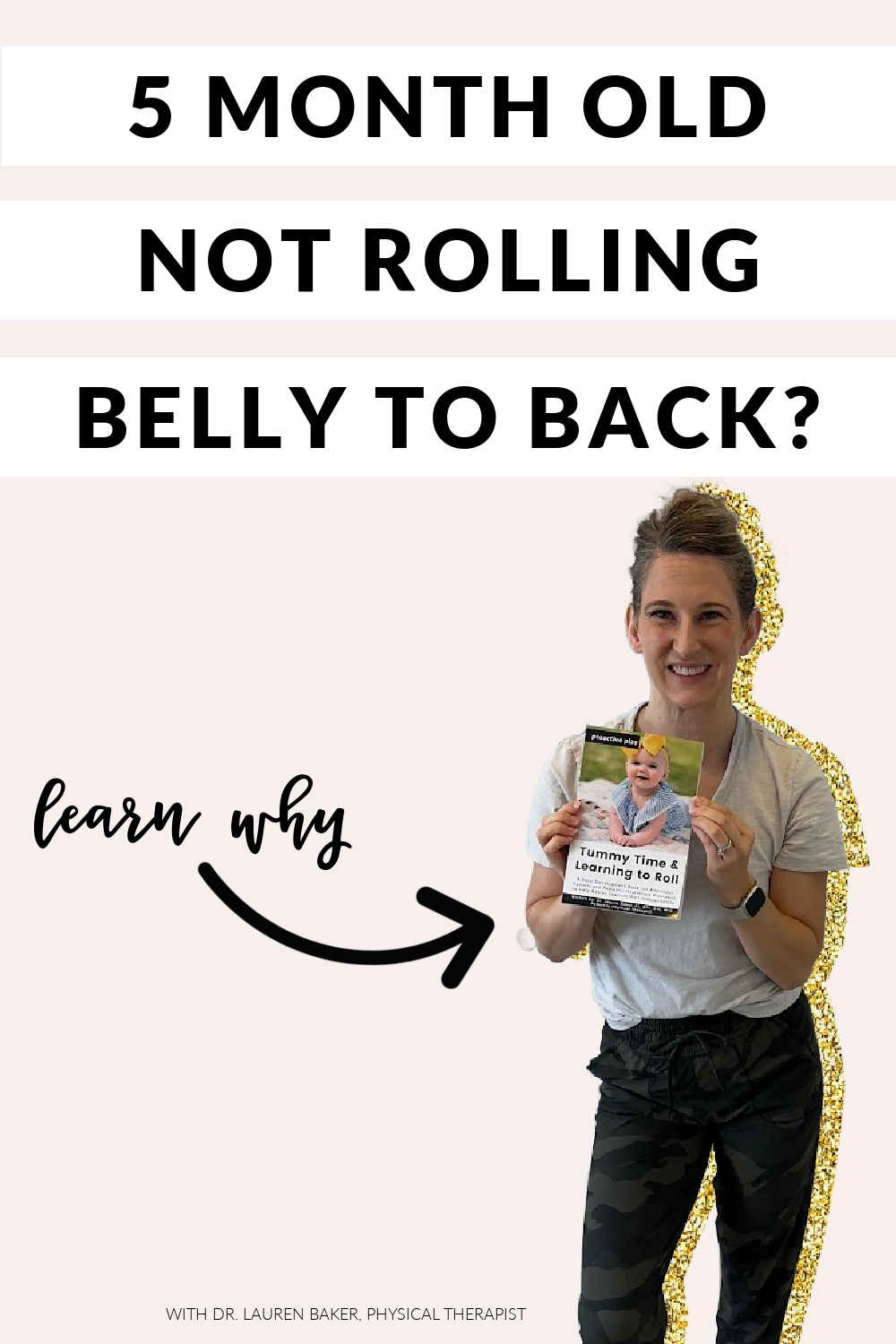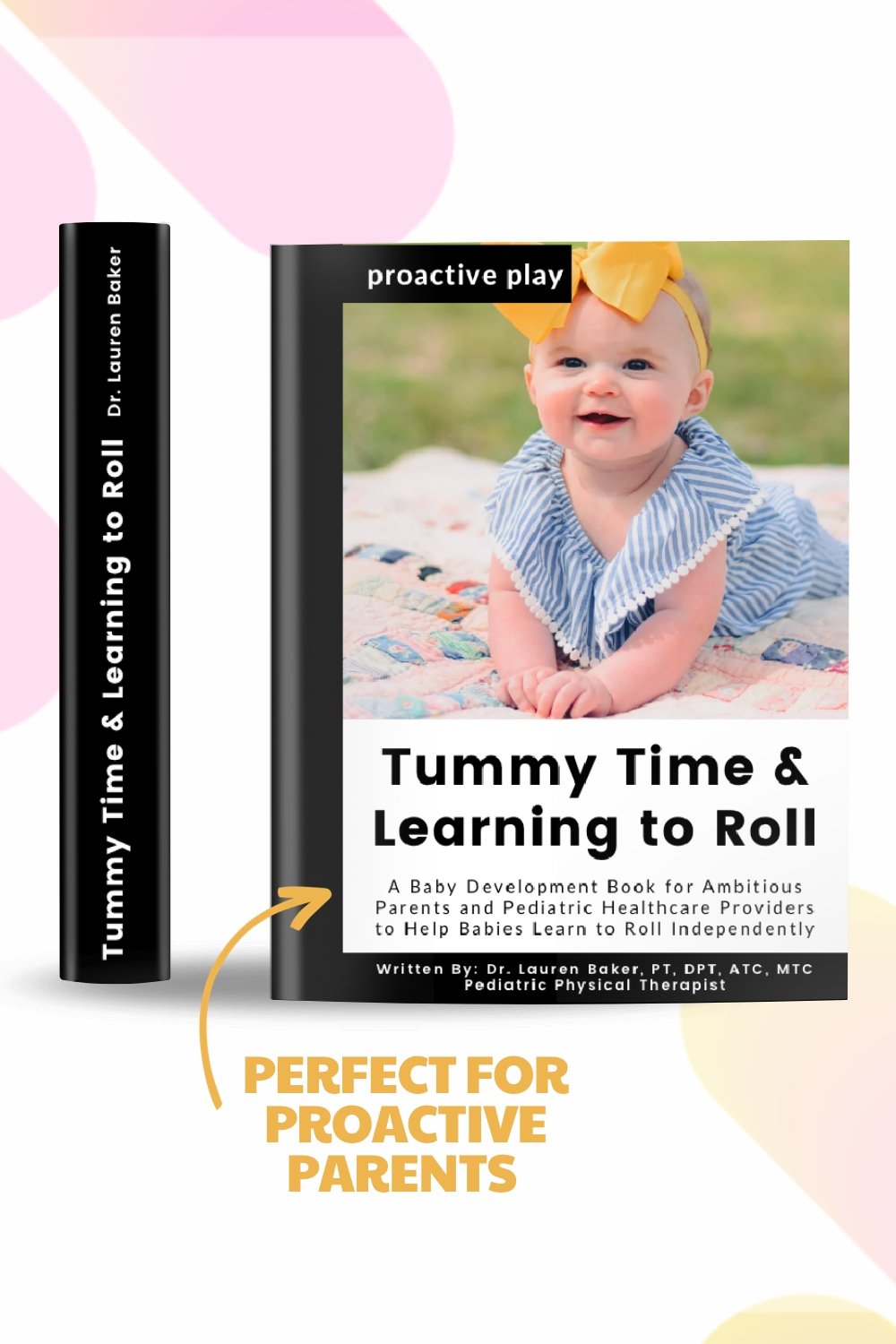Why a 5 Month Old Baby Can't Roll From Tummy to Back
this blog contains affiliate links
Today, I'm excited to share with you some invaluable insights on a topic that can make parents a little worried: helping your baby roll from belly to back, especially if they are 5 months old and not yet doing this milestone on their own!
This essential milestone can sometimes be a puzzle, but this blog post will hopefully fill in some gaps. The youtube video linked below, is the most comprehensive conversation on the topic, so make sure to watch the video.
If we haven’t met yet, Hi! I’m Dr. Baker, a pediatric physical therapist, who helps children 0-4 master their milestones and move with confidence and ease. I believe the more educated eyeballs we have on our babies, the better off our babies are! I am so glad that you are here, learning more about how to help your little move.
Understanding the Rolling Belly to Back Milestone
Rolling from belly to back is more than just a fun milestone to watch babies master; it's a crucial skill that lays the foundation for future milestones like sitting, crawling, and eventually walking.
Around the age of five months, babies are prime for mastering this skill, yet some might need a bit more encouragement and practice. We want all babies to have mastered rolling belly to back by six months of age. If you've noticed your little one is a bit hesitant or struggling with this movement, you're in the right place!
Why Some Babies Struggle with Rolling Belly to Back
There isn't a one-size-fits-all reason why some babies find rolling challenging. It can vary greatly from baby to baby, but common factors include limited tummy time, struggle with coordinating movements, tightness in their body, or simply not having enough practice in various play positions.
The Four Key Play Positions
There are four play positions that are foundational for your baby's physical development:
Tummy Time: Essential for strengthening the neck, shoulders, and upper body. Most important, is that the baby is pushing through both of their elbows to lift both their head and chest off the ground for 5-10 minutes.
Sidelying Play (Right and Left): Helps with balance and coordination, core strength, and neck strength. Sidelying is one of the foundation movements for babies before they can roll on their own, it’s also the most often un-talked about play position (almost NO parents know this is important and I am on a mission to change that!).
Back Play: Important for visual tracking, coordination, head movement, and arm strengthening in a different way than tummy time.
Incorporating these positions into daily play can significantly enhance your baby's ability to roll and master other milestones. Parents always ask, “how much or how long should I do each play position for?” The answer is always: the amount your baby tolerates multiple times a day, with the focus on pushing it a little, tiny bit further each time.
My main goal is often to start at 30 seconds to 1 minute if a baby has a low tolerance and build up 15-30 seconds at a time until the baby is able to tolerate each position for 2-3 minutes. Tummy time should start from day 1 and can include multiple options, when a baby is ready to roll they typically need to be able to first tolerate 5-10 minutes on their belly to have enough strength and coordination to roll out of it or into it.
For the most comprehensive guide, check out the video below as I walk you through how to use my Tummy Time and Learning to Roll book, to help your baby unblock rolling belly to back.
Tips and Tricks for Mastering Rolling Belly to Back
Here are some practical tips to encourage your baby to roll from belly to back, drawn directly from the Tummy Time and Learning to Roll Book.
Increase Tummy Time: Gradually work up to 10-15 minutes of tummy time in a row without breaks, exploring different modifications to keep it engaging and comfortable for your baby. Modifications are easier and typically involve the baby’s shoulders higher than the level of their hips.
This can include tummy time on a wedge, on your chest, on a tummy time pillow, on an exercise ball, or with some support under the chest to help babies build up the strength in their arms to lift their chest on their own without the support. If you need examples, check out the book for a ton of ideas with photographs.
Practice Sidelying Play: This often-overlooked position is crucial. Use cushions or your leg to support your baby in a sidelying position, encouraging them to play and interact from this new perspective.
Place toys at eye level or chest level at first so that babies can play with toys at midline, then as they get stronger move the toys to shoulder level or above shoulder level so the baby can build arm strength in this position to assist with rolling.
Use Toys for Motivation to Reach: Position toys to encourage reaching and turning, which naturally promotes rolling motions. First start with having the baby turn their head to the right and left, making sure they are able to turn both directions equally.
Then start placing toys to the side so that babies can reach their hand out in extension to play while holding their weight on one elbow and reaching with their other hand. Babies need to be able to shift their weight to one elbow without collapsing through their arms, make sure their chest is still lifted from the ground, and reach forward with one hand to the level of their shoulder.
Once this is mastered, babies then need to be able to do the same thing while reaching to the side (harder than reaching forward!). This exercise with photo examples is located in the book.
Make Sure There’s Mobility: In order to successfully roll from belly to back, babies need to be able to rotate the upper half of their body on the lower half of their body. Think of how you need to twist the top half of your body in order to look all the way behind you, that’s the same thing that happens when babies need to roll belly to back, they’re just doing it while lying on their belly and while gravity is trying to just slam them to the ground (so it’s even harder than in sitting!).
Babies need to be able to rotate the top half of their body, their bottom half of their body, and both their top half and bottom half in opposite directions at the same time. If a baby is lacking mobility in their trunk, rolling (in either belly to back or back to belly directions) can be blocked.
OR you might find that a baby literally throws themselves from their belly to their back, almost like they’re vaulting over their elbow, which can result in babies hitting their head on the ground because they don’t have the rotational mobility in their trunk to roll belly to back gently.
All mobility exercises are described along with photo examples in the book.
Be Patient and Positive: Every baby develops at their own pace, but if a baby is over 6 months and still not rolling on their own, they may have a block in their movement and need more help from a Pediatric physical therapist. Know that all of your efforts are building up and that at any time you can reach out for support on your journey. Celebrate small victories and keep the atmosphere positive and encouraging.
If you’re curious how the book can help you solve any blocks holding a baby back from rolling belly to back, watch the video below for a step by step guide on how to use the book to solve this problem.
Curious About Learning More on Tummy Time, Rolling, or Both?
The absolute best book for parents on tummy time and rolling is: Tummy Time and Learning to Roll: A Baby Development Book for Ambitious Parents and Pediatric Healthcare Providers to Help Babies Learn to Roll Independently. The book comes with a free online video course to help parents fully understand how to complete the different exercises, printable checklists to know exactly where your baby is at, and when to reach out for additional help.
This book was written by Dr. Lauren Baker, PT, DPT, ATC, MTC, who is a Pediatric Physical Therapist in Boise, Idaho, trained in helping parents learn how to help their babies move and master their milestones. She loves teaching parents how to see how their babies are moving as well as how to influence those movements though play positions and exercises to help babies move with confidence and ease.
Tummy Time and Learning to Roll is the first book in the Proactive Play series written by Pediatric Physical Therapist Dr. Lauren Baker in order to help Ambitious Parents and Pediatric Healthcare Providers learn how to help babies master tummy time and learn to roll. It is meant to help ambitious parents understand baby development from birth to six months (tummy time to rolling).
This book is a mix of easy-to-follow and more in-depth information than is typically found in baby development books because Dr. Baker believes parents deserve to have all the information at their fingertips.
This book breaks down each piece of movement in checklists so that parents know what their babies need for tummy time and rolling. It also covers what areas might limit a child with rolling, why it is so important, and when to seek help from a pediatric PT.
This book comes with colored photos and easy-to-follow demonstration videos that can help parents implement safe, strategic play-based exercises with their babies in 20 minutes per day.
A Great Resource For:
Parents and Pediatric Healthcare Providers of babies 0-6 months
Parents of babies who are struggling with tummy time, rolling back to belly, belly to back, or only to one side
Access to simple, easy-to-follow videos of play positions and exercises
Learning the four pillars of movement needed in order to master rolling
240+ Color Photo Examples of:
Tummy Time, Sidelying, and Back Play
Developmental Toys and Equipment
Hand Placement and Strategic Play Positions
Common Areas of Restriction or Weakness
When To Reach Out For Help
What If You Want Extra Help?
If you have concerns about their movement, remember, you can always reach out to a pediatric physical therapist. It's your right as a parent to advocate for your child's development.
Sometimes, a few tips and tricks are all you need to get your baby moving better. We're here to support you and release those mama worries. If you are looking for in home pediatric physical therapy, check our listing of therapists.
For those eager to learn more or seeking personalized guidance, I offer online video parent consultations internationally which can be scheduled by clicking here. I am dedicated to answering questions and providing tailored play activities for each unique developmental journey.
When Should Babies Receive Pediatric Physical Therapy?
Parents can call and schedule with a Pediatric Physical Therapist at any time, for any concern in all fifty states without a referral from their Pediatrician.
Pediatric Physical Therapy is medically indicated in all babies who are not rolling in all four directions by six months (back to belly over their right arm AND left arm + belly to back over their right arm AND left arm).
Pediatric Physical Therapy is medically indicated if you notice a flat spot on the back of an infants head (possible plagiocephaly), a tilt of their head consistently to one side (ear to shoulder - possible torticollis), or a rotation preference of their neck (consistently look only to the right or left - possible torticollis).
Many Pediatric Physical Therapists including Dr. Baker, can successfully treat flat spots (Plagiocephaly) without a helmet with a combination of therapy and positioning strategies if seen prior to 4 months (0-3 months is ideal). Dr. Baker uses the Baby Begin Method of repositioning.
Flat spots can be due to in-utero positioning, rotational preference (right sided flatness most common) and babies are at an increased risk for flatness if they are male, were breech, multiple birth, premature, have difficulty with tummy time, or are in containers > 2 hr/day.
Final Thoughts
Remember, you're not alone in this journey. Every baby is unique but we want to make sure that babies have everything they need to master their movement and that we are taking proactive steps to help them resolve any blocks to movement they may be experiencing.
It is important to provide a variety of playful, supportive experiences that encourage movement exploration. For the most comprehensive resource, make sure to check out Tummy Time and Learning to Roll, a fantastic resource packed with exercises, play positions, and expert advice to support you and your baby through this exciting developmental stage.
If you have any concerns or questions, never hesitate to reach out to a healthcare professional who can provide you with tailored advice and support, I love encouraging parents to book with a local Pediatric PT but also offer video online parent consultations to answer questions.
Here's to joyful playtime in cozy homes filled with love and celebrating each new roll, tumble, and turn along the way!







